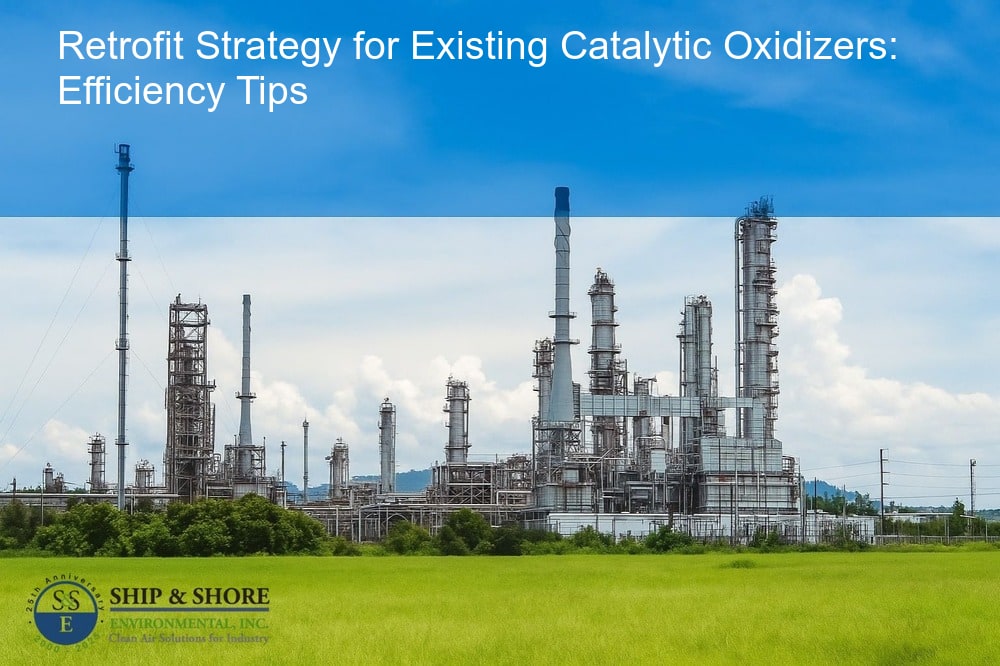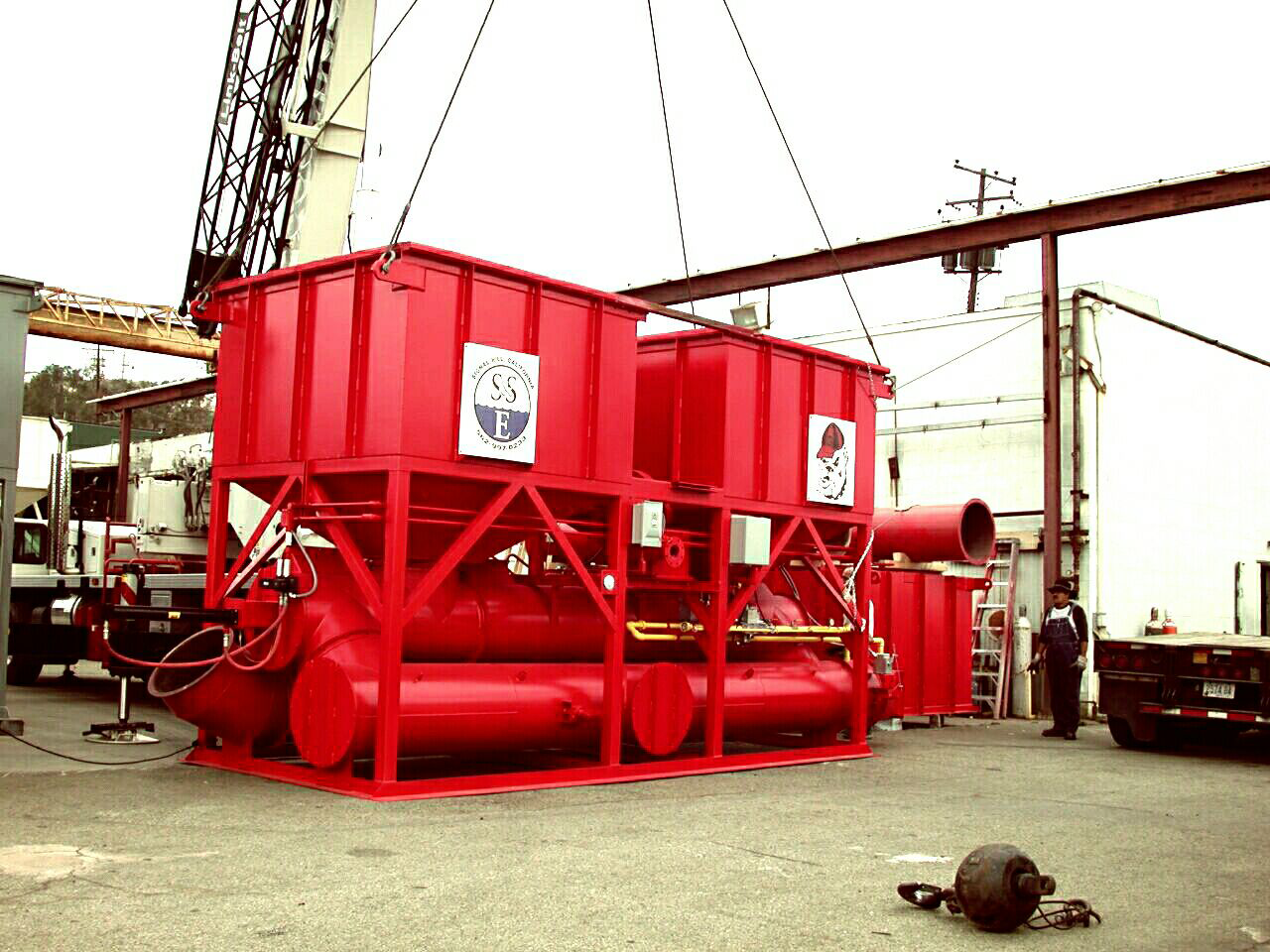
Crafting a Retrofit Strategy for Existing Catalytic Oxidizers
August 20, 2025 6:49 amUnderstanding Catalytic Oxidizers and their Role
At Ship & Shore Environmental, Inc., we recognize the importance of having a robust retrofit strategy for existing catalytic oxidizers. Catalytic oxidizers play a crucial role in reducing volatile organic compounds (VOCs) and other harmful pollutants from industrial exhaust streams. Through chemical reactions facilitated by a catalyst, these devices convert pollutants into less harmful substances, such as carbon dioxide and water vapor. This process not only aids in regulatory compliance but also promotes environmental sustainability.
The Need for Retrofitting Existing Catalytic Oxidizers
Over time, the performance of catalytic oxidizers can diminish due to various factors such as wear and tear, catalyst deactivation, or changes in process conditions. When this happens, the efficiency in removing pollutants can decline, leading to potential non-compliance with environmental regulations. This underscores the importance of retrofitting, which involves upgrading or modifying existing systems to restore or enhance performance. Retrofitting can extend the lifespan of catalytic oxidizers, improve their efficiency, and reduce overall operational costs.
What is a Retrofit Strategy for Catalytic Oxidizers?
A retrofit strategy for catalytic oxidizers involves a planned approach to upgrading the system components and processes that are essential for optimal performance. This could include replacing or revitalizing the catalyst, upgrading control systems, enhancing heat exchange capabilities, or improving the overall design to handle new or increased pollutant loads. By implementing an effective retrofit strategy, industries can achieve significant benefits such as improved air quality, energy savings, and compliance with ever-stricter environmental regulations.
How to Develop a Retrofit Strategy for Existing Catalytic Oxidizers
When developing a retrofit strategy for existing catalytic oxidizers, it is crucial to adopt a comprehensive approach. Firstly, conduct a detailed assessment of the current system. This includes evaluating the efficiency, operational costs, and emission levels of the existing catalytic oxidizer. Next, identify areas for improvement or upgrade. Potential upgrades may involve replacing outdated components, enhancing the heat exchange mechanism, or upgrading the catalyst.
It is also vital to establish clear goals for the retrofit. These objectives may focus on reducing emissions, improving energy efficiency, and extending the operational life of the oxidizer. Furthermore, it is essential to create a well-defined action plan that outlines each step of the retrofit process, complete with timelines and responsible personnel.
Importance of Regular Inspections and Maintenance in Retrofitting Strategies
Regular inspections and maintenance are the keystone of an effective retrofit strategy for existing catalytic oxidizers. Maintenance activities help in identifying potential issues before they escalate into significant problems. Inspections should include a thorough examination of key components, such as the catalyst beds, ductwork, and fans. Additionally, it is crucial to monitor system performance through continuous data collection and analysis.
Routine inspections will also ensure that the oxidizer operates within its optimal parameters. By maintaining the equipment properly, we can reduce the chances of unexpected downtimes, thereby ensuring consistent performance. Additionally, regular maintenance can help in extending the life of the catalytic oxidizer, ultimately providing better returns on investment.
Understanding the Cost and Environmental Benefits of Retrofitting Catalytic Oxidizers
The cost and environmental benefits of retrofitting catalytic oxidizers are multifaceted. Firstly, the retrofit strategy for existing catalytic oxidizers often leads to substantial energy savings. An upgraded system is likely to require less fuel, thereby reducing operational costs. Moreover, enhanced efficiency translates to lower emissions, contributing positively towards environmental conservation.
Additionally, retrofitting can be a cost-effective alternative to replacing the entire system. By upgrading specific components, we can achieve significant improvements in performance without the capital expenditure associated with new installations. A well-planned retrofit can also result in compliance with stricter emission regulations, thereby avoiding potential fines and enhancing our company’s reputation.
The environmental benefits are equally compelling. Upgraded catalytic oxidizers contribute to a reduction in harmful emissions such as volatile organic compounds (VOCs) and hazardous air pollutants (HAPs). By lowering these emissions, we not only meet regulatory standards but also contribute to creating a healthier environment.
- Reducing fuel consumption and operational costs
- Improving system efficiency and performance
- Extending the operational life of the oxidizer
- Ensuring compliance with environmental regulations
- Contributing to environmental conservation
Did you know that retrofitting existing catalytic oxidizers not only helps industries meet stringent environmental regulations but can also lead to significant cost savings by improving energy efficiency and reducing operational downtime?
Implementing Your Retrofit Strategy for Existing Catalytic Oxidizers
The journey to a successful retrofit strategy for existing catalytic oxidizers begins with a thorough assessment and understanding of your current system. This involves identifying areas that require upgrades or replacements to enhance efficiency and ensure compliance with environmental regulations. Once these areas are pinpointed, it’s crucial to design a retrofit plan that prioritizes both short-term and long-term improvements.
Utilizing advanced technologies and materials, we can achieve significant performance enhancements and operational cost savings. By integrating cutting-edge control systems and more durable catalyst materials, we enhance the overall functionality and lifespan of your catalytic oxidizers. This proactive approach not only addresses current inefficiencies but also sets the stage for future adaptability to evolving environmental standards.
The Future of Catalytic Oxidizers: Efficiency and Sustainability
Looking forward, the importance of catalytic oxidizers in industrial pollution control cannot be overstated. As technology evolves, so should our systems. Emphasizing sustainability, it’s essential to continually adopt innovative solutions that reduce environmental impact while maintaining operational efficiency.
One of the key aspects of future developments will be the integration of smart technology to monitor and optimize performance in real-time. These advancements will enable a more responsive and adaptive approach to maintaining optimal conditions within catalytic oxidizers, reducing downtime, and minimizing emissions. Embracing these technologies will not only comply with stricter regulations but also embody a commitment to environmental stewardship.
Final Thoughts on the Importance of Retrofitting Strategies in Industrial Pollution Control
In conclusion, implementing a robust retrofit strategy for existing catalytic oxidizers is essential for maintaining compliance, improving efficiency, and ensuring the sustainability of industrial operations. Regular inspections and maintenance play a critical role in this process, enabling timely identification and resolution of potential issues.
By focusing on continuous improvement and innovation, we can maximize the benefits of our catalytic oxidizers, contributing to a cleaner and healthier environment. This commitment to proactive management and technological advancement reflects our dedication to providing comprehensive solutions for industrial pollution control, ensuring that our clients remain at the forefront of environmental responsibility.
FAQ
How do we start developing a retrofit plan for our catalytic oxidizers?
To develop a retrofit plan for your catalytic oxidizers, begin with a comprehensive assessment of your existing system to identify components that require upgrades or full replacement. This step is crucial to understand the specific needs of your equipment and pinpointing areas for improvement. Subsequently, outline a strategy that includes both immediate and long-term upgrades, ensuring that it aligns with current and future environmental regulations, as well as operational needs.
Why are regular inspections and maintenance crucial in our retrofit plans?
Regular inspections and maintenance are fundamental components of any retrofit plan, as they help in identifying issues before they become major problems, ensuring that your equipment operates at peak efficiency. Furthermore, consistent maintenance extends the lifespan of your catalytic oxidizers and can prevent costly downtime. Timely detection and rectification of issues are also essential for staying compliant with environmental regulations.
What are the cost and environmental benefits of retrofitting our current catalytic oxidizers?
Retrofitting catalytic oxidizers can lead to significant cost savings, primarily through improved energy efficiency and reduced need for replacements. Environmentally, retrofitting contributes to the reduction of harmful emissions, ensuring that your operations have a lower environmental impact. Modifying existing equipment also eliminates the need for new materials, further reinforcing the benefits of retrofit initiatives.
Once we have a retrofit strategy, how do we implement it?
After developing your retrofit strategy, implement it by scheduling the upgrades at times that minimize disruption to your operations. Work with experienced professionals who understand the nuances of catalytic oxidizer systems to ensure that retrofits are executed properly. Moreover, communicate clearly with your team about the schedules and objectives of the retrofit process to foster a smooth transition to the upgraded system.
What technological advancements should we consider for future-proofing our catalytic oxidizer systems?
To future-proof your catalytic oxidizers, consider incorporating smart technology for real-time performance monitoring and optimization. Advances in catalyst materials can also provide enhanced performance and longevity. Embracing such technologies not only supports regulatory compliance but also demonstrates a dedication to environmental stewardship, ensuring that your systems remain cutting-edge and efficient.
Categorised in: Blog

